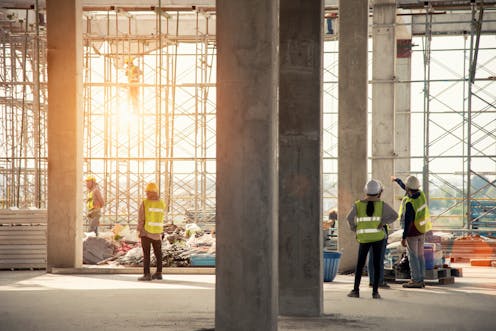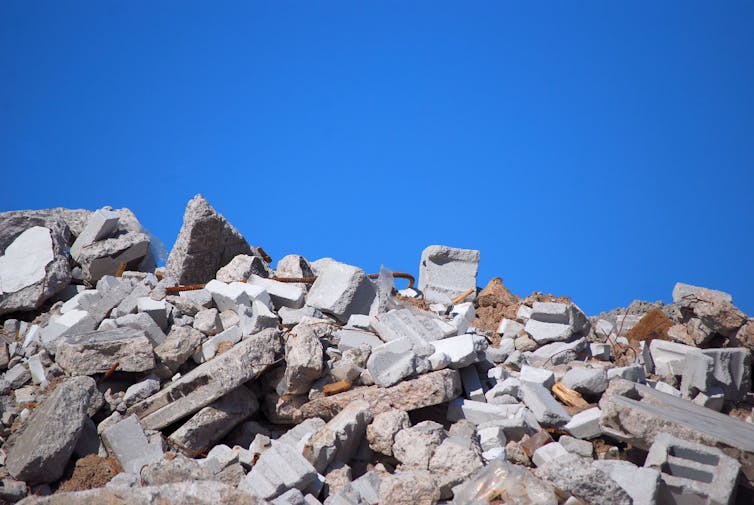
Up to 8% of all global anthropogenic human-made emissions are due to just one material, cement. And our use of it is rising.
The cement and concrete industry is encouraging this use, for example, by claiming that using concrete will reduce the “whole life” carbon emissions from buildings.
The absence of regulations to measure this has allowed such claims to play an important role in persuading designers and specifiers to use certain products. However, research conducted by my colleagues and me shows that these claims are often, at the least, exaggerated.
We identified the use of three such claims. First is the claim that because concrete has a high thermal mass, which allows it to act as a heat store, it will reduce the carbon emissions from heating and cooling a building during its life.
The second claim is that concrete is more durable than other materials, and that therefore concrete buildings will last longer, reducing the need to build new. The third is based on the ability of concrete to undergo carbonation, in which carbon dioxide is slowly absorbed from the atmosphere. This means that concrete can be seen as a “carbon sink”, and so is a sustainable choice.
These messages, among others, are promoted by the Mineral Products Association (MPA), the UK’s trade association, through their technical guidance and their sector roadmap to “beyond net zero”. Similar messages have been repeated by the European concrete industry.
Our research reveals a very different picture.
Absorbing heat won’t cut heating use
First, while concrete’s thermal mass does indeed allow it to act as a store of heat, or “coolth”, this is likely to do little to reduce the carbon emissions from heating buildings. Concrete’s capacity to absorb heat is instead more likely to necessitate an increase in heating energy use, since the concrete needs to be heated as well as the room space.
This can be illustrated by considering stone-built churches, which give testament to the challenges of heating buildings with high thermal mass. It is true that the use of exposed concrete may reduce the need for cooling, particularly in deep plan office buildings. However, in relatively cool climates such as the UK, cooling still uses only a fraction of the energy of heating.
What’s more, cooling is predominantly powered by the national electricity grid, which is rapidly being decarbonised. Our research shows that the calculations for using construction materials that take lots of carbon to make, in order to save decreasing amounts of future operational carbon, just don’t add up.
Buildings are replaced before they need to be
The second argument, durability, is similarly flawed. Our research found that few buildings are demolished because they have reached structural obsolescence. Instead they are destroyed to make way for “regeneration” in areas which are economically booming.
There is also little evidence to suggest that concrete buildings are more durable than others. The number of exposed concrete buildings and structures which have “concrete cancer”, in which the steel reinforcement bars have started to rust and degrade and the concrete to break, suggests rather the opposite.
Meanwhile, millions of ancient buildings around the world constructed of timber, as well as brick and stone, suggest that other building materials can be highly durable.
Concrete buildings don’t absorb much carbon
Finally, the ability of concrete to absorb carbon is typically oversold. Only the exposed surface of concrete will carbonate. So concrete situated underground, or hidden under coatings or cladding, will not act as a carbon sink.
Reinforced concrete is also designed to minimise carbonation, as this leaves the steel reinforcement vulnerable to rusting. Carbonation therefore occurs mainly after the end of life of the building, once the concrete is crushed.
If concrete rubble is left exposed to air, it will slowly reabsorb a proportion of the carbon dioxide emissions that were emitted in its original manufacture. This is more correctly understood as “partial re-carbonation” and scarcely represents a good argument for using additional high-carbon concrete in new buildings.

Is the tide changing?
During 2021-22, the UK government’s Environmental Audit Committee held an inquiry into the sustainability of the UK’s built environment. In their response to the inquiry, the MPA again repeated its claims of thermal mass, durability and carbonation.
However, the report on the outcome of the inquiry does not repeat these claims. Instead, it encourages the increased use of lower carbon materials such as timber, and calls for the measurement of the whole life carbon of buildings to be included in regulations.
Alongside the recent introduction of such regulations in several European countries, this should support a move away from high-carbon materials. The accurate measurement and genuine reduction of carbon, both as embodied in the materials and resulting from the operation of a building, are essential to reducing our impact on the environment.
Alice Moncaster has received funding in the past from UKRI (EPSRC, AHRC and ESRC), the WhitbyBird Foundation, the Equilibrium Network, the Isaac Newton Trust, the Irish Green Building Council and Buckinghamshire Council. As well as the Open University she is affiliated with the Department of Engineering at the University of Cambridge, Cambridge Architectural Research, and the Equilibrium Network. She is a Member of the Institution of Civil Engineers, and a member of the Green Party. The AHRC funded a small portion of the research described, but no other organisation provided funding.
This article was originally published on The Conversation. Read the original article.







